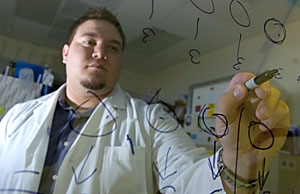 |
|
CHRIS CODUTO / Arizona Daily Wildcat
|
Research technician Manuel Snyder is just one of the many people who will benefit from a $19.5 million grant to the Arizona Cancer Center by the National Cancer Institute.
|
|
|
By Monica Warren
Arizona Daily Wildcat
Wednesday, September 15, 2003
Print this
The Arizona Cancer Center's fight against skin cancer will continue in southern Arizona until at least 2010, thanks to a $19.5 million grant awarded to the center by the National Cancer Institute.
The award is "the largest program project grant in the center's history," according to a press release.
"Skin cancer is of epidemic proportions in southern Arizona," said Dr. David Alberts, co-principal investigator of the Cancer Center's Chemoprevention of Skin Cancer Program Project.
"We have two to three times the rate of skin cancer as the rest of the U.S.," he said. "Our rates of skin cancer are second in the world only to Brisbane, Australia. It's related to the fact that we have 3,800 hours of sunlight per year and people live outdoors."
The grant will fund four projects, which will focus on skin cancer prevention and the development of new drugs that can be added to sunscreens, Alberts said.
Three of the projects include pre-clinical research performed in Tucson, Phoenix and at the University of Minnesota, said Tim Bowden, one of the co-principal investigators on the project. The final project will apply the discoveries made during research to patients in the center's clinic, Bowden said.
The ultimate goal of the project is to develop a topical treatment that can identify and destroy molecular targets in the skin, Alberts said.
Bowden's project at the cancer center and the research being conducted at the University of Minnesota focus on non-melanoma skin cancers and the effect ultraviolet rays have on the skin, Alberts said.
They are searching for molecular abnormalities in the skin that can lead to cancer, Alberts said.
Once these abnormalities have been located, they can be targeted and destroyed, either by natural products, like elements found in citrus peels, or by small molecules that can be added to a lotion to prevent skin cancer, Alberts said.
Research being conducted in Phoenix focuses on melanoma carcinoma, the most deadly type of skin cancer, Alberts said.
The award was presented to the center following a grant application and a site visit by peer scientists, Bowden said.
"The excellence of past work and the scope and depth of the proposed project," along with the qualifications of the project's staff, resulted in the highest scoring grant proposal submitted this year, according to a press release.
The cancer center has been receiving the grant since 1980, Bowden said. The grant provides funding for five years, Alberts said.
"Unfortunately the incidence rates are going up for both melanoma and non-melanoma skin cancers" in southern Arizona, Bowden said.
"Eighty percent of cumulative sun damage is achieved before age 18," Alberts said. "So we really have to develop a strategy that will affect young people."
Alberts recommends that people stay out of the sun whenever possible, especially during the middle of the day. He says that sunscreen with an SPF of at least 15 should be used when being in the sun is unavoidable.
"I guarantee that these young women who are sunbathers will wake up in their mid-30s and say, 'Oh my God! What did I do to myself?'" Alberts said.
